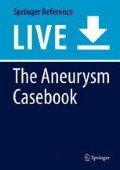Abstract
Saccular aneurysms occur in up to 10% of patients with coarctation of the aorta and are frequently multiple. Aneurysm size tends to increase with age, as does the risk of rupture. Uncontrolled hypertension promotes the growth of these aneurysms and increases the risk of rupture. Following a mechanistic approach, treatment of aortic coarctation aims to control the stenotic segment; however, even after adequate anatomical repair and irrespective of the approach used, up to 30–40% of patients develop systemic arterial hypertension. Adding to this puzzle, the risk of aneurysm rupture remains after the coarctation has been repaired, even if there is no longer any hypertension (Kenny and Hijazi 2011). In some ways, aortic coarctation could be considered a systemic vascular disease of the precoarctation arteries. A 24-year-old woman experienced an episode of sudden onset severe headaches, vomiting, and loss of consciousness, ending up in a deep coma. She was assisted by paramedics, who rapidly intubated her and transferred her to our hospital emergency room. On admission, the patient was in a coma (Glasgow Coma Score [GCS] 6) with right-hand anisocoria. CT/CTA of the head revealed a diffuse subarachnoid hemorrhage (SAH), left frontobasal and intraventricular hemorrhage with associated hydrocephalus (Fisher grade 4), and a midsized irregularly shaped aneurysm on the bifurcation of the left internal carotid artery (ICA). Emergent external ventricular drainage was put in place to alleviate increased intracranial hypertension and the patient was immediately transferred to the neurointerventional department. During the diagnostic angiography, we discovered a stent implanted in the proximal descending aorta. We crossed over this implanted aortic stent and confirmed the presence of an irregularly shaped midsized saccular aneurysm on the bifurcation of the left ICA. The aneurysm was embolized using a balloon-assisted coiling technique in a procedure that was considered to have been straightforward and unremarkable. The aneurysm was completely excluded, and at the end of the intervention the gradient across the aortic stent was 24 cmH2O. The patient was transferred to ICU for clinical and neurological monitoring. Her clinical course was complicated by pneumonia and vasospasm. The patient was extubated on postoperative day 12 and was transferred to a rehabilitation facility on day 23. At 60 days, she was able to walk independently and she recovered even further after intense rehabilitation work. Her headache pain was successfully treated with nonsteroidal anti-inflammatory drugs (NSAIDS) and opioid analgesics. This case exemplifies an unusual medical situation: the urgent need for the endovascular embolization of a brain aneurysm in a patient with an aortic stent implanted for the management of aortic coarctation. The association between aortic coarctation and brain aneurysms and the increased risk of aneurysm rupture, even after aortic repair, are the main topics of this chapter.
References
Benyounes N, Blanc R, Boissonnet H, Piotin M. Subarachnoid hemorrhage revealing aortic coarctation in a young man. Neuroradiology. 2011;53(11):931–2. https://doi.org/10.1007/s00234-011-0851-5.
Connolly HM, Huston J 3rd, Brown RD Jr, Warnes CA, Ammash NM, Tajik AJ. Intracranial aneurysms in patients with coarctation of the aorta: a prospective magnetic resonance angiographic study of 100 patients. Mayo Clin Proc. 2003;78(12):1491–9. https://doi.org/10.4065/78.12.1491.
Curtis SL, Bradley M, Wilde P, Aw J, Chakrabarti S, Hamilton M, Martin R, Turner M, Stuart AG. Results of screening for intracranial aneurysms in patients with coarctation of the aorta. AJNR Am J Neuroradiol. 2012;33(6):1182–6. https://doi.org/10.3174/ajnr.A2915.
Egbe AC, Padang R, Brown RD, Khan AR, Luis SA, Huston J 3rd, Akintoye E, Connolly HM. Prevalence and predictors of intracranial aneurysms in patients with bicuspid aortic valve. Heart. 2017;103(19):1508–14. https://doi.org/10.1136/heartjnl-2016-311076.
Hoffman JI, Kaplan S. The incidence of congenital heart disease. J Am Coll Cardiol. 2002;39(12):1890–900. https://doi.org/10.1016/s0735-1097(02)01886-7.
Kenny D, Hijazi ZM. Coarctation of the aorta: from fetal life to adulthood. Cardiol J. 2011;18(5):487–95. https://doi.org/10.5603/cj.2011.0003.
Malebranche AD, McPherson T. Aortic coarctation in a 49-year-old female. BC Med J. 2014;56:278–281. https://www.bcmj.org/articles/aortic-coarctation-49-year-old-female
Mercado R, Lopez S, Cantu C, Sanchez A, Revuelta R, Gomez-Llata S, Bouffard JA, Pineda C. Intracranial aneurysms associated with unsuspected aortic coarctation. J Neurosurg. 2002;97(5):1221–5. https://doi.org/10.3171/jns.2002.97.5.1221.
Pickard SS, Gauvreau K, Gurvitz M, Gagne JJ, Opotowsky AR, Jenkins KJ, Prakash A. Stroke in adults with coarctation of the aorta: a national population-based study. J Am Heart Assoc. 2018;7(11). https://doi.org/10.1161/JAHA.118.009072.
Serizawa T, Satoh A, Miyata A, Kobayashi S, Odaki M, Nakamura H, Watanabe Y. Ruptured cerebral aneurysm associated with coarctation of the aorta – report of two cases. Neurol Med Chir (Tokyo). 1992;32(6):342–5. https://doi.org/10.2176/nmc.32.342.
Warnes CA, Williams RG, Bashore TM, Child JS, Connolly HM, Dearani JA, Del Nido P, Fasules JW, Graham TP Jr, Hijazi ZM, Hunt SA, King ME, Landzberg MJ, Miner PD, Radford MJ, Walsh EP, Webb GD. ACC/AHA 2008 guidelines for the management of adults with congenital heart disease: a report of the American College of Cardiology/American Heart Association Task Force on Practice Guidelines (Writing Committee to Develop Guidelines on the Management of Adults with Congenital Heart Disease). Developed in collaboration with the American Society of Echocardiography, Heart Rhythm Society, International Society for Adult Congenital Heart Disease, Society for Cardiovascular Angiography and Interventions, and Society of Thoracic Surgeons. J Am Coll Cardiol. 2008;52(23):e143–263. https://doi.org/10.1016/j.jacc.2008.10.001.
Author information
Authors and Affiliations
Corresponding author
Editor information
Editors and Affiliations
Rights and permissions
Copyright information
© 2020 Springer Nature Switzerland AG
About this entry
Cite this entry
Cohen, J.E., Shoshan, Y., Danenberg, H., Planer, D., Honig, A., Rajz, G. (2020). Internal Carotid Artery Bifurcation Aneurysm: Ruptured Internal Carotid Artery Aneurysm in a Patient with Corrected Coarctation of the Aorta Treated with Balloon-Assisted Coiling, Exclusion of the Aneurysm, and Good Clinical Outcome. In: Henkes, H., Lylyk, P., Ganslandt, O. (eds) The Aneurysm Casebook. Springer, Cham. https://doi.org/10.1007/978-3-319-70267-4_166-1
Download citation
DOI: https://doi.org/10.1007/978-3-319-70267-4_166-1
Received:
Accepted:
Published:
Publisher Name: Springer, Cham
Print ISBN: 978-3-319-70267-4
Online ISBN: 978-3-319-70267-4
eBook Packages: Springer Reference MedicineReference Module Medicine

